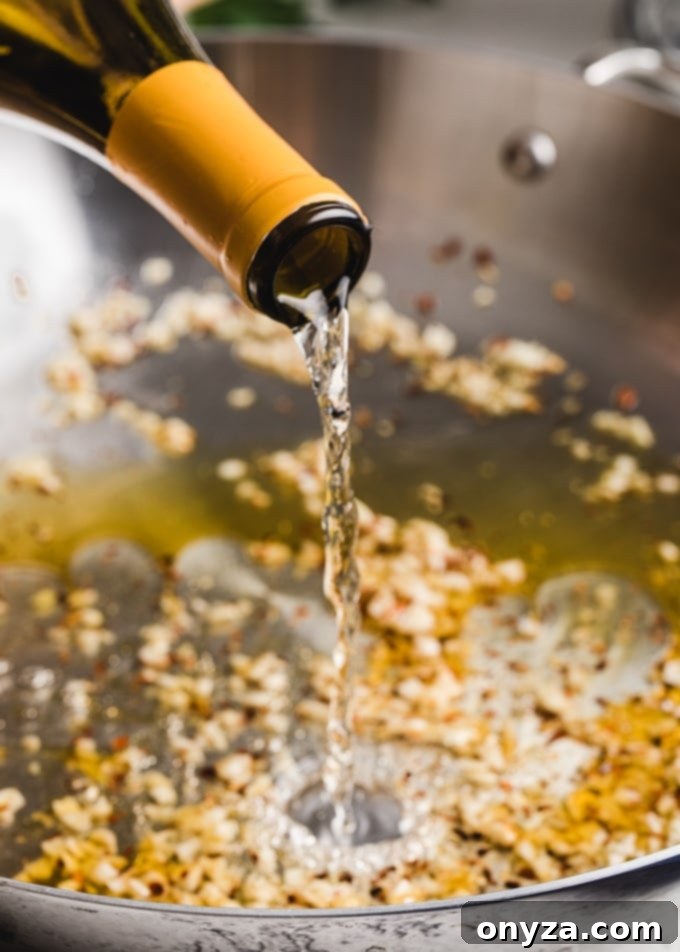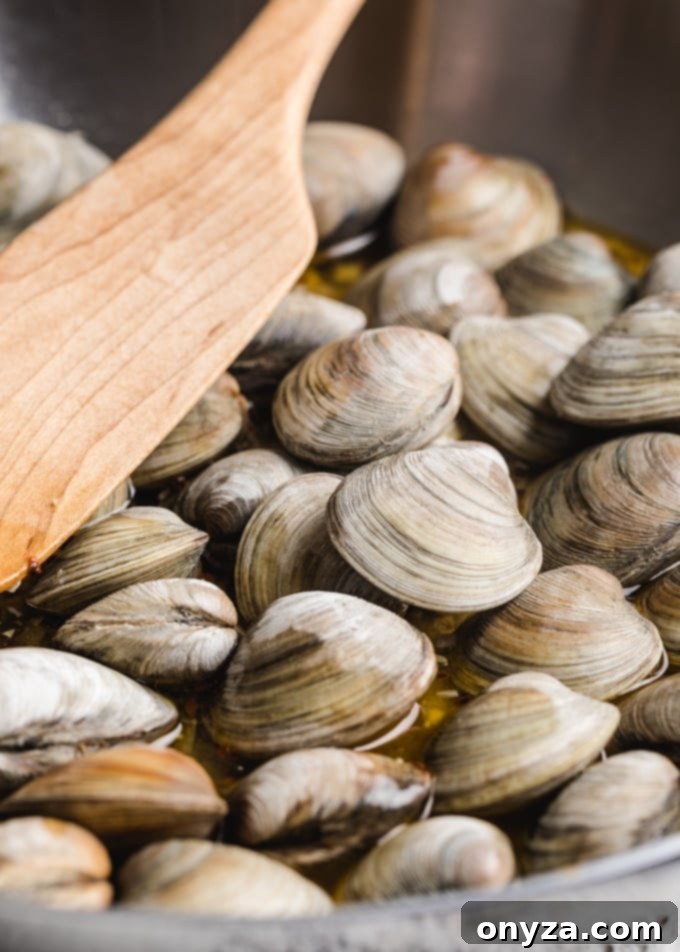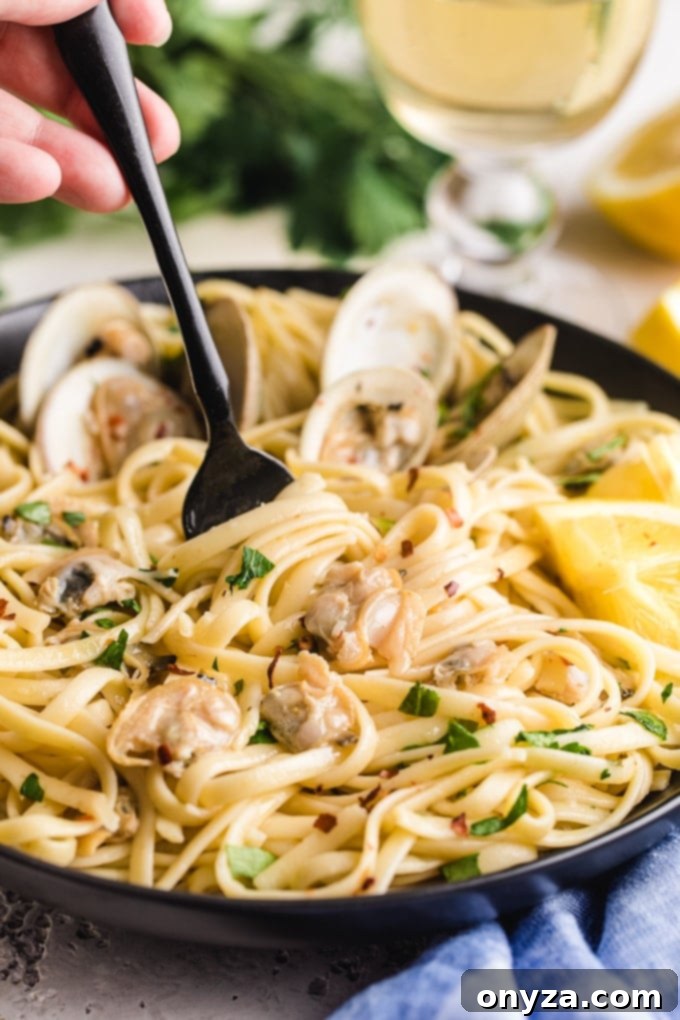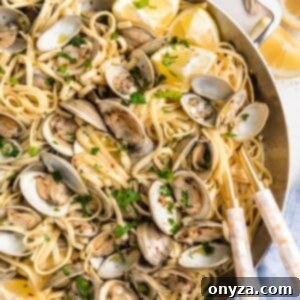Transform your kitchen into a cherished Italian bistro with this simple yet sublime Linguine with Clams (Linguine alle Vongole). This classic white clam sauce recipe, a treasured family heirloom passed down through generations, promises a delicious meal that perfectly encapsulates the essence of summer.
Among the vast array of dishes in any dinner repertoire, few evoke the spirit of summer quite like a generous bowl of Linguine with Clams, affectionately known as Linguine alle Vongole in Italy. This iconic Neapolitan creation beautifully combines the best elements of the warmer months: it’s bright, incredibly fresh, and surprisingly light, yet deeply comforting and satisfying. It’s the quintessential meal for a relaxed evening on the patio, shared with loved ones, enjoying good company and even better food.
Linguine with Clams traditionally comes in two delightful variations: “in bianco” (with white clam sauce) or “in rosso” (with a tomato-based red clam sauce). Our family’s cherished recipe, perfected by my grandmother Josephine (or “Nanny” as we called her), is always prepared in bianco. It features a harmonious blend of crisp white wine, an abundance of fragrant fresh garlic, a squeeze of bright lemon juice, and a subtle (or not-so-subtle, depending on your preference!) kick from red pepper flakes. This version has been a beloved summer tradition in our Italian family for generations, a particular favorite of my late father, and a dish I find myself craving multiple times each season.

Crafting the Perfect Linguine with Clams: A Guide to Authentic Flavor
The secret to an exceptional Linguine with Clams lies in the simplicity of its ingredients. With so few components, the quality of each element becomes paramount. From the succulent clams to the crisp white wine and the rich olive oil, selecting the best possible ingredients will elevate your dish from good to truly extraordinary. Think of it as investing in flavor – a small upgrade in quality makes a significant impact on the final taste.
For the wine, I highly recommend a nice Sauvignon Blanc or a dry Pinot Grigio. You don’t need to splurge on an expensive bottle, but do choose a wine that you would genuinely enjoy drinking on its own. Not only will this ensure a superior flavor in your sauce, but it also means you’ll have a delightful glass to sip while you cook and enjoy with your meal, as the recipe won’t require the entire bottle.
Choosing the Right Clams for Your Pasta
When preparing Linguine with Clams, I personally prefer using either **fresh Littleneck or Manila clams**. Both varieties are celebrated for their delicate flavor, inherent sweetness, and perfectly tender, meaty texture. They provide just enough substance without becoming overly chewy, which can sometimes happen with larger, tougher clams. These smaller, sweeter clams truly shine in a light pasta sauce.
Before you even think about cooking, it is absolutely crucial to **clean live clams thoroughly**. This preventative step is vital to avoid any unwelcome grit or sand from finding its way into your perfectly cooked pasta. Trust me, I’ve been there, and a sandy bite can quickly ruin an otherwise wonderful meal! For comprehensive, step-by-step instructions on how to properly scrub, de-grit, and select the freshest clams at the market, I highly recommend consulting a detailed Fresh Clams Guide. This will ensure your clams are pristine and ready to deliver their best flavor.

Perfectly Steaming Clams for Linguine alle Vongole
Once your clams are meticulously cleaned, the cooking process is surprisingly quick. They will only require a few minutes to steam open in a flavorful broth created by the white wine and aromatic ingredients. Littleneck clams typically take about 5-8 minutes to fully open, while the smaller Manila clams might be ready even faster, in just 3-5 minutes.
To achieve the best results, instead of using a deep pot, I find that a wide-bottomed pan works wonders. A **12-inch skillet or a 13-inch braiser** (like the one pictured in the photos) is ideal. This wider surface area allows the clams to steam in a single, even layer, promoting uniform cooking and ensuring every clam opens beautifully. More importantly, it provides ample space to finish cooking the linguine directly in the rich, briny clam juices, infusing the pasta with incredible flavor.
For truly tender and succulent clams, it’s essential to **monitor them closely and avoid overcooking**. Fresh clams are the undeniable stars of this dish, and prolonged cooking will quickly render them tough and rubbery, diminishing their delicate appeal. The moment their shells pop open, they are ready. Since clams can cook at slightly different rates, a useful technique is to **start checking them a little early** in the cooking window. Instead of waiting for the entire batch to steam open, remove each clam individually as soon as its shell opens and transfer it to a holding bowl. You’ll often hear distinct “pops” from the pan as they open – that’s the delightful sound of perfectly cooked clams!
It’s important to note that **any clams that do not open during the cooking process should be discarded.** While some might be a bit stubborn and need a minute or two longer than the rest, any clam that remains stubbornly shut after a reasonable extension (say, 3-5 minutes past the general cooking window) was likely perished before it even reached your pan. These are not safe to eat, so it’s always best to err on the side of caution.

Mastering the Pasta: Cooking and Flavoring for Authentic Alle Vongole
The profound and utterly delicious flavors in this dish originate from the incredible **briny clam juices** that collect in the pan. When these precious juices mingle with the aromatic garlic, vibrant lemon juice, and crisp white wine, the resulting broth is nothing short of heavenly. The key to creating a truly outstanding bowl of Linguine with Clams lies in ensuring that this magnificent flavor permeates the pasta itself, turning a simple dish into an unforgettable culinary experience.
To achieve this, my family employs a simple yet effective technique. We remove the linguine from its pot when it’s **just shy of al dente** (meaning “to the tooth” – still firm but not hard). Before draining, we always remember to reserve about a cup of the starchy pasta water; this liquid gold can be used later to perfectly adjust the consistency of the sauce if needed. The partially cooked linguine is then transferred directly into the steaming clam broth in the wide pan to finish cooking. This allows the pasta to absorb the incredible flavors, becoming deeply infused with the essence of the sea.
My grandmother, Nanny, always added a generous knob of unsalted butter to the pan just before the pasta. This simple addition enriches the sauce, adding a luxurious gloss and depth of flavor. Within a couple of minutes, the linguine continues to cook, absorbing some of that delicately flavored liquid, creating a velvety, glossy sauce that lightly clings to each strand of pasta, rather than sitting separately at the bottom of the bowl. This integration of flavors is what defines a truly exceptional Linguine alle Vongole.
Understanding the Difference Between Spaghetti and Linguine
Both spaghetti and linguine are beloved long pasta shapes, but they possess distinct characteristics. Spaghetti, whose name charmingly translates to “little twine,” is typically round in cross-section and relatively thin. In contrast, Linguine, meaning “little tongues,” is flatter and slightly wider than spaghetti, though still considerably narrower than other ribbon-like pastas such as tagliatelle or fettuccine. This unique, flattened shape of linguine makes it particularly adept at catching and holding lighter sauces, making it a traditional choice for seafood preparations.
Exploring Pasta Alternatives: Can You Use Spaghetti in This Dish?
Absolutely! While linguine is my personal favorite for this particular dish and a classic choice for delicate seafood sauces, **spaghetti or even spaghettini are common and perfectly acceptable substitutions for Pasta alle Vongole**. Spaghettini, being thinner, will typically cook a minute or two faster than linguine, so adjust your cooking times accordingly. The beauty of Italian cooking often lies in its adaptability and using what you have on hand.
Beyond spaghetti, you can confidently substitute almost any long pasta shape in this recipe, such as the thinner tagliolini or the hollow bucatini. Each will offer a slightly different texture and mouthfeel, allowing you to customize the experience. However, I personally find very delicate pastas like capellini or angel hair a bit too fine to properly stand up to the plump clams and the richness of the sauce. Conversely, heartier shapes like fettuccine or pappardelle might be too robust, potentially overwhelming the delicate flavors of the clams. The ideal pasta strikes a balance, providing structure without overshadowing the star ingredients.
For those eager to expand their pasta knowledge and brush up on the myriad of shapes available, this Visual Guide to Pasta from Epicurious offers a fantastic overview and will help you choose the perfect pasta for any dish.

Serving Linguine with Clams: Enhancing the Dining Experience
To truly savor the clams at their peak plumpness and succulence, Linguine alle Vongole is a dish that demands to be **served immediately** upon completion. The warmth and freshness are key to its exquisite flavor. I love to present this magnificent dish directly to the table either in the steaming pan itself – a gleaming stainless steel braiser makes for a beautiful and rustic presentation – or artfully arranged on a large, warm platter, allowing everyone to appreciate its visual appeal before diving in.
The perfect finishing touches for this classic Italian meal include a generous sprinkle of freshly chopped parsley, a few bright lemon wedges for an extra burst of zest, and a final drizzle of high-quality, fruity olive oil. These simple garnishes enhance the flavors without overwhelming them. In keeping with a long-standing tradition in many Italian households, we never serve grated cheese with this dish (or indeed, with most seafood pastas). We believe that the strong flavors of cheese, even a delicate Parmesan, tend to overpower the subtle, delicate taste of the fresh clams, detracting from the dish’s true essence.
Just as we do with my Beer Steamed Clams and Pasta with Mussels, we invariably enjoy Linguine alle Vongole alongside a crusty, freshly baked bread. The delectable, brothy sauce in this dish is particularly ideal for dipping, allowing you to soak up every last drop of its incredible flavor. This communal element of dipping bread also adds to the relaxed and comforting dining experience that this dish is meant to provide.
To Shell or Not to Shell: Presenting Your Clams
When it comes to serving clams in pasta, recipes often vary. Many instructions suggest removing all the clams from their shells and tossing the succulent meat directly into the pasta before serving. Others advocate for serving the clams whole in their shells, allowing guests the pleasure of scooping the clam meat from each shell individually as they enjoy their meal.
Our family often takes a “half and half” approach. We remove half of the clams from their shells and mix the tender meat into the pasta, ensuring every forkful has a delightful bite of clam. The remaining half are left whole, beautifully arranged on top of the pasta, adding to the visual appeal and offering that satisfying hands-on experience for those who enjoy it. Ultimately, the serving style for this cherished family dish is truly a matter of personal preference. Feel free to choose the presentation that you and your family find most appealing and enjoyable.

Save (Functionality removed)
Pin (Functionality removed)
Print (Functionality removed)
Linguine with Clams (Linguine alle Vongole)
Ingredients
- 3 to 4 pounds littleneck clams , cleaned
- 1 pound linguine
- ¼ cup olive oil , plus additional for serving
- 5 to 8 cloves garlic , chopped (quantity depending on how garlicky you like the dish)
- ¼ to ½ teaspoon crushed red pepper flakes (more or less, to taste)
- 1 cup dry white wine (choose a bottle you’d drink)
- ¼ cup fresh lemon juice (increase or decrease, to taste)**
- 3 tablespoons unsalted butter
- ⅓ cup chopped fresh parsley , plus 2 tablespoons for garnish
- kosher salt
Instructions
- Sort and clean clams following the instructions in a Fresh Clams Guide.
- Cook linguine in a large pot of salted boiling water until it’s about a minute shy of al dente, approximately 8 minutes (the pasta will finish cooking in the clam sauce and should retain a slight firmness).
- While the pasta is cooking, heat ¼ cup of olive oil in a deep skillet, sauté pan, or braiser (12-14 inches wide). Add garlic and red pepper flakes and cook, stirring, until the garlic is lightly browned and fragrant, about 1-2 minutes.
- Add white wine, lemon juice, and clams to the pan, cover, and steam over medium-high heat until the clamshells have opened, about 5-8 minutes.
Gently shake the pan occasionally. It’s best to start checking the clams at the earlier end of the cooking range, transferring them one at a time to a holding bowl as they open. For perfectly tender clams, it’s crucial not to overcook. Loosely tent the bowl of cooked clams with foil to keep them warm.
(A few clams might need a little extra time. Discard any clams that do not open after 10-13 minutes.)
- Reserve ½ to 1 cup of pasta water before draining the linguine. Once all the clams are cooked and removed from the pan, whisk 3 tablespoons of butter into the simmering steaming liquid.
- Add the drained linguine to the pan, tossing to coat thoroughly. Cook for about 2 minutes, until the linguine is perfectly al dente. The sauce should be brothy, yet it will lightly cling to the noodles. If the linguine appears dry at any point, stir in some of the reserved pasta water, as needed, to achieve the desired consistency.
- Stir the chopped parsley into the pasta. Season to taste with salt*, additional red pepper flakes, and lemon juice**, if needed.
- At this point, you have a choice: you can either remove all the clams from their shells and stir the meat into the pasta, or serve the pasta tossed with or topped with the whole clams for guests to de-shell at the table. Our family prefers a “half and half” approach, removing the meat from about half of the clams and leaving the other half whole for presentation and guest preference.
- Garnish the dish generously with a final drizzle of fruity olive oil, fresh lemon wedges, and the remaining parsley. Serve immediately with crusty bread for dipping into the delicious sauce.
Notes
*The amount of kosher salt you’ll need depends entirely on the natural salinity of your clams. There have been times I’ve added upwards of a full teaspoon of salt to the pasta before serving, and other times when only a small pinch was necessary. Always taste and adjust accordingly.
**We adore the bright, zesty flavor that ¼ cup of lemon juice adds to the sauce. If you prefer a less pronounced lemon flavor, begin by adding 2 tablespoons when steaming the clams, and then incorporate additional lemon juice into the pasta in step 7, to taste.
Nutrition Estimate
Nutrition information is automatically calculated, so should only be used as an approximation.
Please note that our recipes have been developed using the US Customary measurement system and have not been tested for high altitude/elevation cooking and baking.
Like this? Rate and comment below!
